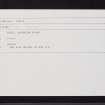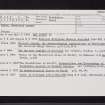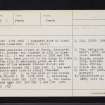Following the launch of trove.scot in February 2025 we are now planning the retiral of some of our webservices. Canmore will be switched off on 24th June 2025. Information about the closure can be found on the HES website: Retiral of HES web services | Historic Environment Scotland
Perth, Dominican Friary
Friary (Medieval)
Site Name Perth, Dominican Friary
Classification Friary (Medieval)
Alternative Name(s) Black Friars' Monastery
Canmore ID 28428
Site Number NO12SW 6
NGR NO 1178 2386
Datum OSGB36 - NGR
Permalink http://canmore.org.uk/site/28428
- Council Perth And Kinross
- Parish Perth
- Former Region Tayside
- Former District Perth And Kinross
- Former County Perthshire
NO12SW 6 1178 2386.
See also NO12SW 135 and NO12SW 213.
(NO 1178 2386) Supposed site of Black Friars Monastery (1231) (NR)
OS 1/500 map (1863)
The Dominican friary at Perth, dedicated to St Andrew, was founded in 1231 by Alexander II. It was destroyed in 1559 and its lands etc. were granted to the Burgh in 1569.
The site is variously given as at the corner of the present Kinnoul Street and Carpenter Street (NO 1168 2390), the east or south east side of Atholl Crescent (NO 117 239), on the site of the Middle Free Church (NO 1176 2388), adjoining the North Port (NO 1177 2374), the Blackfriars Wynd (NO 118 238) and (NO 1181 2385).
(Information from M E C Stewart to OS).
D E Easson 1957; R S Fittis 1885; Name Book 1860; R Milne 1893.
Excavations in 1983 located the remains of the Dominican Friary (NO12SW 6) and part of the monastic cemetery (NO12SW 213). Earlier than the friary was a large ditch of unknown function, perhaps Roman in date. A later ditch was probably part of a Joacobite earthwork. Remains of 19th century workshops were also found.
D Bowler, A Cox and C Smith 1995.
NO 117 238 (centre) Archaeological investigation was undertaken at the site adjacent to the Dominican Friary (NO12SW 6). A watching brief in May 2002 and the excavation of an evaluation trench revealed three main archaeological phases. Phase 1 comprised medieval garden soil and two ditch features. Phase 2 comprised the remains of pre-modern buildings with pantile roofs, probably mainly industrial, a cobbled floor, and a well. Phase 3 revealed the below-ground brick-built tanks and massive pillar bases of the Pullars cleaning and dyeworks and subsequent refurbishment for Prestos supermarket.
From April to June 2004, during a watching brief on the groundworks for the new build, medieval garden soil was investigated but no further evidence of the medieval ditches was revealed.
Archive to be deposited in the NMRS.
Sponsor: Mansell Partnership Homes Ltd.
R Cachart 2004
Publication Account (1982)
The Dominican friary is popularly said to have been founded by Alexander II in 1231, although the first known grant to the house was in October 1241 (Cowan, 1976, 119). The land granted to the friary was where the castle had stood and included the king's garden, and the friars were also allowed to have a water supply from a conduit taken from the mill dam at the king's mills (Stavert, 1981, 17). Royal grants, guests and patronage conspired to make the Perth Dominicans among the wealthiest in Scotland. A zealous mob attacked the buildings as early as 1543, and in May 1559 it was destroyed along with the other friaries in Perth. A slightly later, but far poorer foundation had been the Carmelites of Tullilum, on the outskirts of Perth. One of the last friaries to be founded in Scotland was the order of Observant Grey Friars who were granted lands by King James IV on the South Inch. At the Reformation their former property became a municipal burying ground.
Information from ‘Historic Perth: The Archaeological Implications of Development’ (1982).












